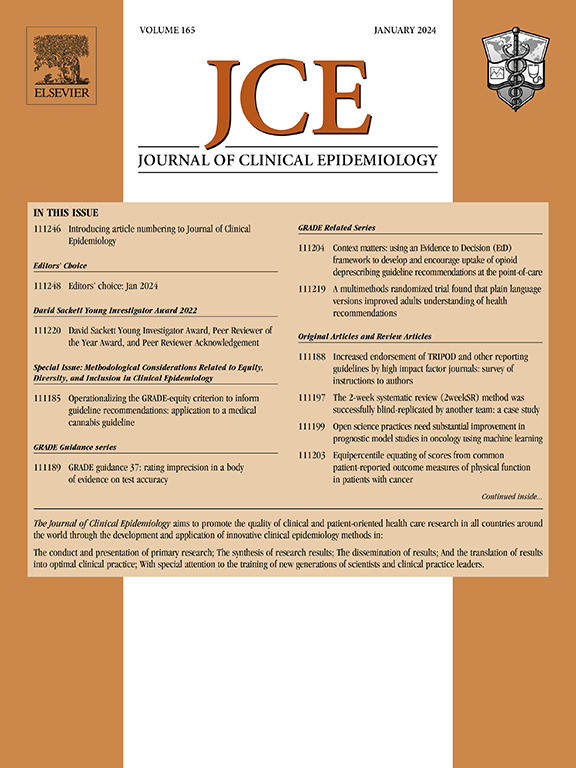开发,运行和评估指南制定会议的模拟。
IF 5.2
2区 医学
Q1 HEALTH CARE SCIENCES & SERVICES
引用次数: 0
摘要
这篇论文是关于什么的?关于医疗保健的重要决定是在指南会议上做出的。因此,让受决策影响的人参与进来是很重要的。这可以包括患者、卫生保健工作者和决策者。然而,参加指导方针会议的人可能并不总是理解过程或对他们的期望。为了解决这个问题,我们在那里开发了一个指南会议的模拟。在本文中,我们描述了我们如何开发,运行和评估模拟。我们也为其他想要这样做的人提供指导。我们做了什么?我们在挪威开发并运行了五个模拟。我们选择了一个关于使用远程医疗的建议作为我们的模拟主题。我们邀请了准备或使用指南的人,或者将来可能这样做的人。每个参与者都扮演指南制定小组成员的角色。一些人扮演远程医疗专家的角色,而另一些人则扮演保健专业人员或患者代表的角色。参与者参加了一个预备会议,我们向他们介绍了指南主题和方法。一周后,他们参加了一个结构化的指导会议,在那里他们讨论了证据并提出了建议。参与者对模拟有什么看法?我们询问了参与者对模拟的反馈。我们还观察了每个模拟并做了笔记。参与者将模拟描述为有用、有趣、有教育意义和令人愉快的。大多数参与者喜欢角色扮演元素,尽管有些人一开始持怀疑态度。参与者认为,在提出建议之前,有足够的时间阅读和讨论证据是很重要的。他们还认为做好充分准备很重要。然而,大多数人在会议前没有阅读材料,并希望他们准备得更好。我们利用这些反馈来改进模拟。通过描述我们如何开发、运行和评估我们的模拟,并提供实用指导,我们的目标是支持其他人在他们的环境中开发类似的模拟。本文章由计算机程序翻译,如有差异,请以英文原文为准。
Developing, running, and evaluating a simulation of a guideline development meeting
Objective
We developed a simulation of a guideline development group (GDG) meeting to increase people’s knowledge and familiarity with the guideline development process. In this paper, we describe how we developed, ran, and evaluated the simulation and offer guidance to others who wish to do the same.
Study design and setting
We ran five simulations in Norway, hosted by one hospital, two universities, and one public health institute. Our development process included determining the simulation’s aim and objectives; defining our target audience; developing simulation content, including selecting the guideline topic; preparing meeting materials; defining, preparing and allocating roles; determining the simulation length and structure; and evaluating and improving the simulation.
We gathered data regarding participants’ expectations and feedback about positive and negative aspects of the simulation and made note of our observations during simulations and used this information to inform cycles of improvement.
Results
We defined our target audience as people involved in commissioning, preparing, using, or disseminating guidelines. We selected an existing World Health Organization recommendation as our guideline topic. We prepared the same meeting materials as for a real guideline meeting, using the GRADE Evidence-to-Decision (EtD) framework. We developed roles for GDG members, chair, methodologist, guideline commissioner, and observers. We gave participants GDG member roles. The simulation included an online preparatory meeting and a face-to-face meeting.
Overall, participants were positive to the simulation, describing it as useful, interesting, educational, and enjoyable. Most participants were enthusiastic about the role-play element, although some were initially sceptical. Other issues we identified include the need for sufficient time to read and discuss the evidence before making a recommendation; the importance of well-prepared chairs, methodologists, and participants; and the usefulness of preparatory meetings. Participants found the time used for simulation was suitable. Some suggested providing more information in advance. However, most had not read the materials beforehand and wished they had prepared better.
Conclusion
Participants participating in a simulation of a guideline development process experienced this as useful and enjoyable. By offering practical guidance, we hope to support others developing similar simulations.
求助全文
通过发布文献求助,成功后即可免费获取论文全文。
去求助
来源期刊

Journal of Clinical Epidemiology
医学-公共卫生、环境卫生与职业卫生
CiteScore
12.00
自引率
6.90%
发文量
320
审稿时长
44 days
期刊介绍:
The Journal of Clinical Epidemiology strives to enhance the quality of clinical and patient-oriented healthcare research by advancing and applying innovative methods in conducting, presenting, synthesizing, disseminating, and translating research results into optimal clinical practice. Special emphasis is placed on training new generations of scientists and clinical practice leaders.
 求助内容:
求助内容: 应助结果提醒方式:
应助结果提醒方式:


